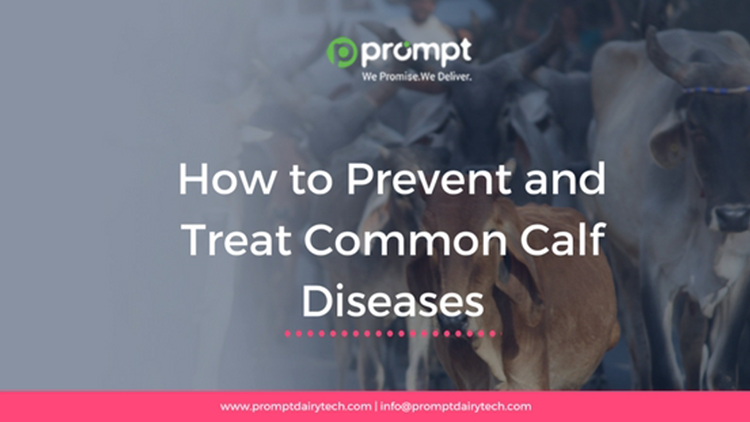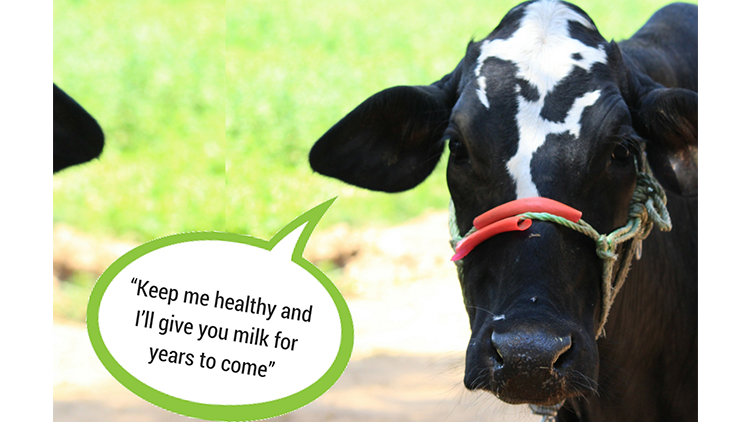It is crucial to protect new-born calves against diseases as their bodies aren’t yet fully developed to a level that they can to ward off illnesses on their own. Managing young calves is equally important as other as other aspects of Animal Husbandry. Let’s go through the list of a few extended diseases occurring in young calves and the necessary measures that could be taken to relieve them.
- Scours
A scour is a clinical symptom characterized by diarrhea that prevents the absorption of fluids in the intestine. The bowel lining is damaged resulting in body fluids passing into the gut causing rapid dehydration. Scour is caused by bacteria (E. coli, salmonella), viruses (rotavirus, coronavirus), and parasites (Cryptosporidium, coccidiosis in older calves). These agents are passed out in excrement from other heard-mates in the housing area, build up as infections and picked up by young calves only to make them ill. Hence, the cow pens must be cleaned and disinfected regularly.
How to treat?
The first step when you notice a calf with a scour must be to separate it and its mother from the rest of the herd and keep them away in a different barn. It is to avoid the infection from spreading amongst the healthy calves. Make sure to not take the calf off of its mother’s milk. Serve extra fluids or electrolyte solution to the calf to substitute the body fluids lost by the calf. A minimum one dose of electrolyte solution must be fed to the calf in a day. The frequency of dosage can be increased depending on the severity of the scour infection. The antibiotics aren’t useful if viruses and parasites cause the scour. It is needed when calf’s temperature is beyond the normal range (38.5°C to 39.5°C), it is weak or incapable to stand, doesn’t feed on milk, or passes out blood in its excrement. Suitable vaccinations can also be given to the calf to prevent scour but must not be considered the sole method of prevention.
- Pneumonia
The typical symptoms of pneumonia include coughing, fever, heavy breathing, nasal discharge, reduced appetite, dullness, and dropped ears. The disease is caused by bacteria (Pasteurella, Haemophilus and Mycoplasma) and viruses (RSV, PI3, IBR, BRCV and BVDV). As it is a communicable disease, the infection is spread amongst the calves by exhaling nasal droplets from other animals. A few other factors favoring pneumonia include calves getting too little colostrum, ventilation-deprived housing, stress, abrupt changes in weather, and keeping cows of all ages and breed together.
How to treat?
Firstly, separate the sick calf and its mother and group them in a different barn to prevent dispersal of pneumonia amongst other animals. Treat the sick calves under the instructions and supervision of a veterinary. Anti-inflammatories are given as prevention beforehand. Antibiotics treat only bacterial infections. Therefore, an early and accurate diagnosis along with the help of your vet is suggested to enable strategic treatment using vaccines.
- Navel Ill/Joint Ill
Navel ill is a disease affecting the umbilical cord of the young calves. The umbilical cord is made up of blood vessels that supply oxygen and nutrients to the calf during gestation. At the time of birth, the cord is cut which makes it open and exposed to the environmental infections. Though the disease remains confined to the navel cord, it is likely that the bacterial contamination spreads throughout the calf’s body, often proving fatal if the cord is not sealed. At times, the infection settles down in the joints of the body causing pain and damage to cartilage, joints and ligaments. Such a condition is called ‘Joint Ill’.
How to treat?
The infection in and around the navel might also result in an abscess. Thus, draining the abscess along with an appropriate antibiotic medication will clear out the infection. The veterinarians recommend improving the hygiene of the calf’s housing. One must ensure that the bedding is in place, clean, warm, and dry. There should be ample drinking water sources around to keep the calves dehydrated. The teats and naval of the cows and calves must be cleaned and dipped in iodine disinfectants during and post the birth.
- Coccidiosis
The disease is caused by protozoan parasites that rapidly multiply and rupture the lining of the intestinal wall. Such situation occurs following any stressful events like sudden weather changes or if the calves are living in an unhygienic condition like poorly ventilated sheds, wet and dirty bedding, overcrowding, impure feed and water containers, etc. The symptoms of coccidiosis comprise of watery diarrhea (often blood-stained), dehydration, strain, anorexia, and weight loss.
How to treat?
Isolate the affected calf to prevent other animals from getting affected by the disease. Provide antibiotics and fluids to the cows to fight off the infection. Sulfonamides and Amprolium drugs are given in medication. The animals may not consume the medicines introduced through feed or water, and profoundly affected animals may have to be treated individually. If there is one infected animal in the herd, it is highly probable that other animals too might be exposed to the contamination in intermediary stages of development. Anticoccidial preventive therapies are used as preventive measures and administered through cattle ration and supplements.



